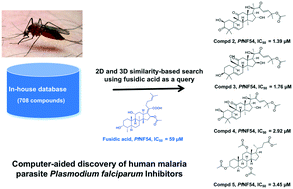Identification of steroid-like natural products as antiplasmodial agents by 2D and 3D similarity-based virtual screening†‡
Abstract
The emergence of drug resistance in Plasmodium falciparum to available antimalarial drugs has challenged current antimalarial treatments. New antimalarials, particularly those with novel mechanisms of action and no cross resistance to current drugs, are therefore urgently needed. To identify new growth inhibitors of Plasmodium falciparum, 2D and 3D similarity-based virtual screening methods were employed in parallel with an in-house database of steroid-type natural products using fusidic acid as a search query. The resulting hit compounds were further filtered based on the predicted partition coefficient, log P. The virtual screening strategy resulted in the identification of nine new compounds that inhibited parasite growth with IC50 values of <20 μM. Four compounds exhibited IC50 values in the range of 1.39–3.45 μM and three of which showed a promising selectivity index. Further, the predicted ADME properties of the four most active compounds were found to be comparable to fusidic acid. These compounds can be further explored using structural modifications in the identification and development of more potent parasite growth inhibitors with improved selectivity.



 Please wait while we load your content...
Please wait while we load your content...